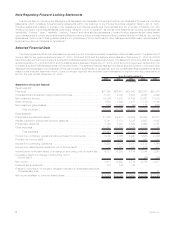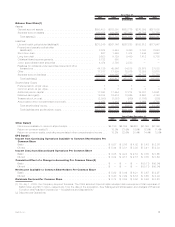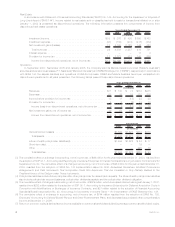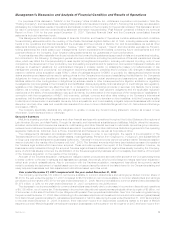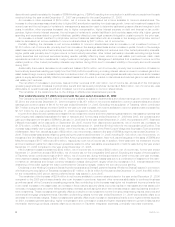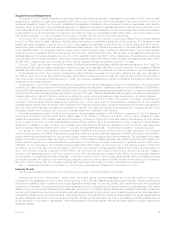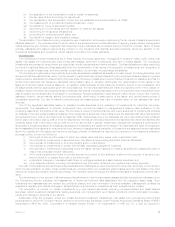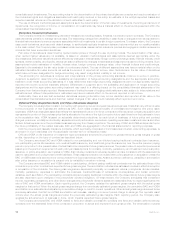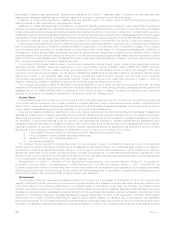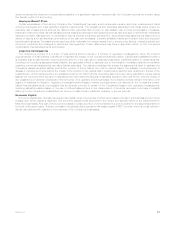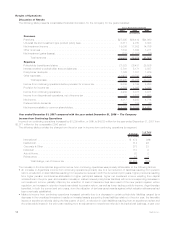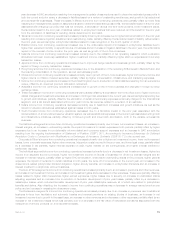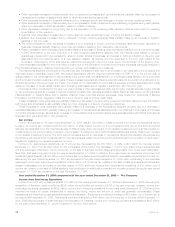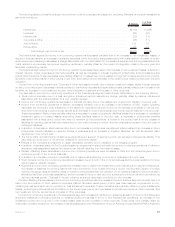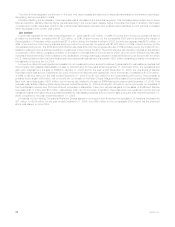MetLife 2007 Annual Report Download - page 16
Download and view the complete annual report
Please find page 16 of the 2007 MetLife annual report below. You can navigate through the pages in the report by either clicking on the pages listed below, or by using the keyword search tool below to find specific information within the annual report.are payable. Utilizing these assumptions, liabilities are established on a block of business basis. If experience is less favorable than
assumptions, additional liabilities may be required, resulting in a charge to policyholder benefits and claims.
Liabilities for future policy benefits for disabled lives are estimated using the present value of benefits method and experience
assumptions as to claim terminations, expenses and interest.
Liabilities for unpaid claims and claim expenses for property and casualty insurance are included in future policyholder benefits and
represent the amount estimated for claims that have been reported but not settled and claims incurred but not reported. Other policyholder
funds include claims that have been reported but not settled and claims incurred but not reported on life and non-medical health insurance.
Liabilities for unpaid claims are estimated based upon the Company’s historical experience and other actuarial assumptions that consider
the effects of current developments, anticipated trends and risk management programs, reduced for anticipated salvage and subrogation.
The effects of changes in such estimated liabilities are included in the results of operations in the period in which the changes occur.
Future policy benefit liabilities for minimum death and income benefit guarantees relating to certain annuity contracts and secondary and
paid up guarantees relating to certain life policies are based on estimates of the expected value of benefits in excess of the projected
account balance and recognizing the excess ratably over the accumulation period based on total expected assessments. Liabilities for
universal and variable life secondary guarantees and paid-up guarantees are determined by estimating the expected value of death
benefits payable when the account balance is projected to be zero and recognizing those benefits ratably over the accumulation period
based on total expected assessments. The assumptions used in estimating these liabilities are consistent with those used for amortizing
DAC, and are thus subject to the same variability and risk.
The Company offers certain variable annuity products with guaranteed minimum benefit riders. These include guaranteed minimum
withdrawal benefit (“GMWB”) riders and guaranteed minimum accumulation benefit (“GMAB”) riders. GMWB and GMAB riders are
embedded derivatives, which are measured at fair value separately from the host variable annuity contract, with changes in fair value
reported in net investment gains (losses). The fair values of GMWB and GMAB riders are calculated based on actuarial and capital market
assumptions related to the projected cash flows, including benefits and related contract charges, over the lives of the contracts,
incorporating expectations concerning policyholder behavior. These riders may be more costly than expected in volatile or declining
markets, causing an increase in liabilities for future policy benefits, negatively affecting net income.
The Company periodically reviews its estimates of actuarial liabilities for future policy benefits and compares them with its actual
experience. Differences between actual experience and the assumptions used in pricing these policies, guarantees and riders and in the
establishment of the related liabilities result in variances in profit and could result in losses. The effects of changes in such estimated
liabilities are included in the results of operations in the period in which the changes occur.
Income Taxes
Income taxes represent the net amount of income taxes that the Company expects to pay to or receive from various taxing jurisdictions
in connection with its operations. The Company provides for federal, state and foreign income taxes currently payable, as well as those
deferred due to temporary differences between the financial reporting and tax bases of assets and liabilities. The Company’s accounting for
income taxes represents management’s best estimate of various events and transactions.
Deferred tax assets and liabilities resulting from temporary differences between the financial reporting and tax bases of assets and
liabilities are measured at the balance sheet date using enacted tax rates expected to apply to taxable income in the years the temporary
differences are expected to reverse. The realization of deferred tax assets depends upon the existence of sufficient taxable income within
the carryback or carryforward periods under the tax law in the applicable tax jurisdiction. Valuation allowances are established when
management determines, based on available information, that it is more likely than not that deferred income tax assets will not be realized.
Significant judgment is required in determining whether valuation allowances should be established, as well as the amount of such
allowances. When making such determination, consideration is given to, among other things, the following:
i) future taxable income exclusive of reversing temporary differences and carryforwards;
ii) future reversals of existing taxable temporary differences;
iii) taxable income in prior carryback years; and
iv) tax planning strategies.
The Company may be required to change its provision for income taxes in certain circumstances. Examples of such circumstances
include when the ultimate deductibility of certain items is challenged by taxing authorities or when estimates used in determining valuation
allowances on deferred tax assets significantly change or when receipt of new information indicates the need for adjustment in valuation
allowances. Additionally, future events, such as changes in tax laws, tax regulations, or interpretations of such laws or regulations, could
have an impact on the provision for income tax and the effective tax rate. Any such changes could significantly affect the amounts reported
in the consolidated financial statements in the year these changes occur.
As described more fully in “— Adoption of New Accounting Pronouncements”, the Company adopted FIN No. 48, Accounting for
Uncertainty in Income Taxes — An Interpretation of FASB Statement No. 109 (“FIN 48”) effective January 1, 2007. Under FIN 48, the
Company determines whether it is more-likely-than-not that a tax position will be sustained upon examination by the appropriate taxing
authorities before any part of the benefit can be recorded in the financial statements. A tax position is measured at the largest amount of
benefit that is greater than 50 percent likely of being realized upon settlement.
Reinsurance
The Company enters into reinsurance transactions as both a provider and a purchaser of reinsurance for its life and property and
casualty insurance products. Accounting for reinsurance requires extensive use of assumptions and estimates, particularly related to the
future performance of the underlying business and the potential impact of counterparty credit risks. The Company periodically reviews
actual and anticipated experience compared to the aforementioned assumptions used to establish assets and liabilities relating to ceded
and assumed reinsurance and evaluates the financial strength of counterparties to its reinsurance agreements using criteria similar to that
evaluated in the security impairment process discussed previously. Additionally, for each of its reinsurance contracts, the Company
determines if the contract provides indemnification against loss or liability relating to insurance risk, in accordance with applicable
accounting standards. The Company reviews all contractual features, particularly those that may limit the amount of insurance risk to which
the reinsurer is subject or features that delay the timely reimbursement of claims. If the Company determines that a reinsurance contract
12 MetLife, Inc.


